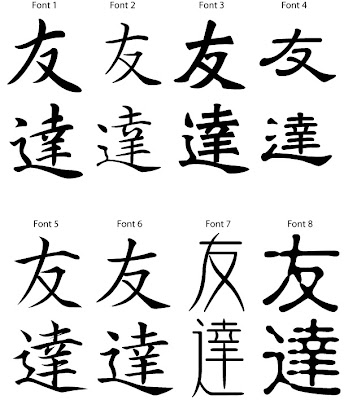History of Kanji, Japanese Kanji
Kanji is one of the letters used by residents of China and Japan. Kanji literally means "Han characters from", the Chinese characters used in Japanese. Kanji is one of four sets of characters used in modern Japanese writings in addition to kana (katakana, hiragana) and romaji.
Kanji used to be called or where Shinji to distinguish it from the kana. Kanji characters used to represent concepts or ideas (noun, verb root, root adjectives, and adverbs). Meanwhile, hiragana (katakana ancient times) is generally used as okurigana to write inflected verbs and root words that he said was written with the kanji, or the original words of Japanese. In addition, hiragana is used to write the words that difficult to write and keep in mind when written in kanji characters. Except for the word picked, kanji characters used to write almost all of the vocabulary comes from Chinese and Japanese.
Officially, Chinese characters first became known in Japan through the goods imported from China via the Korean Peninsula starting the 5th century AD. Since then, many Chinese characters used to write in Japanese, including for the inscription of the stone and other goods.
Earlier at the beginning of the 3rd century AD, two men named Achiki and Wani came from Baekje in the reign of Emperor Ōjin. Both are said to be teaching Chinese characters for the emperor's son. [1] Wani brought the book Analects Kong Hu Chu's work and textbook writing Chinese characters for the children with the title of the Thousand Character Classic. However, Japanese people may already know Chinese characters since the 1st century AD. Kyushu found gold seal from the year 57 AD received as a gift from China to the king of Wa (Japan).
The oldest documents written in Japan, according to estimates written descendants of immigrants from China. Palace of the descendants of immigrants from China employs to work on the palace as a clerk. They wrote the ancient Japanese Yamato kotoba called in Chinese characters. In addition, they also write down important events and happenings.
Before the well known Japanese kanji characters, Japanese developed without a written form. At first, the Japanese language document written in Chinese, and pronounced according to how to read Chinese. Kanbun system is a way of writing the Japanese language Chinese language equipped according to the diacritical marks. When read, the diacritical marks to help speakers of Japanese to change the wording, adding a particle, and inflected according to the rules of Japanese grammar.
Subsequently developed writing system that uses man'yōgana Chinese characters to represent Japanese sounds. This system is used in classical poetry anthology Man'yōshū. While writing man'yōgana, Chinese characters written in cursive form to save time. The result is hiragana which is the simplest form of man'yōgana. Hiragana writing system that is easy to be controlled by women. Colored Heian era literature works of great women writers who write in hiragana. Meanwhile, katakana was created by monks who take only a small portion of the partial stroke kanji characters used in man'yōgana.









